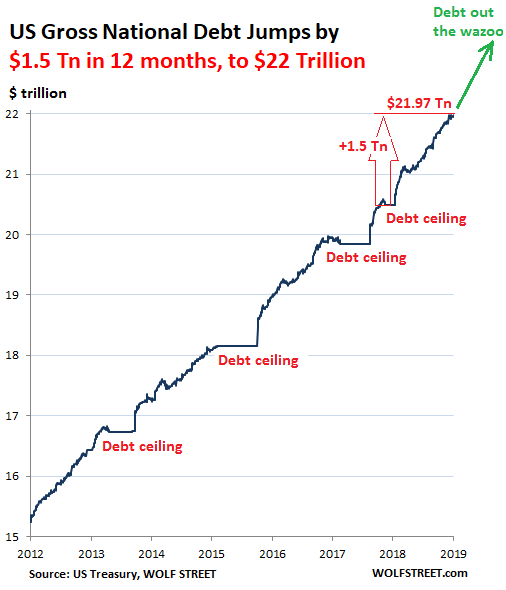US Adds $1.5 Trillion to Debt in 12 Months; Who’s Buying All These Bonds?
Over the past 12 months, the US federal government has added $1.5 trillion to the national debt.
As of Jan 30, the debt stood just under the $22 trillion mark at $21.97 trillion, according to the latest Treasury Department data. As WolfStreet put it, we’re seeing these rapidly increasing levels of debt during “good times when the economy is hopping. At the next recession, this is going to get cute.”
But even as the US added to its debt load, foreign holders of US Treasurys are gradually selling them off. So, who’s buying up all of this debt? And is it sustainable?

Between November 2017 and November 2018, all foreign investors combined slashed their holdings of marketable Treasury securities by $105 billion. Foreign investors now hold $6.2 trillion, according to the Treasury Department’s TIC data released last week.
Foreign official holders of US debt (i.e. foreign central banks and government entities) shrank their holdings of US Treasurys by $144 billion over the last 12 months. China and Japan rank as the two biggest holders of US debt.
- China’s holdings fell by $55 billion from a year earlier to $1.12 trillion.
- Japan’s holdings fell by $47 billion from a year earlier to $1.04 trillion. Japan has reduced its investments in US paper by 16% since the peak at the end of 2014 ($1.24 trillion).
Over the last decade, the Federal Reserve has been a major player in the US bond market, monetizing a big chunk of the US debt. But over the last year, the Fed has been engaged in quantitative tightening, shedding $204 billion in US bonds from its balance sheet. The US central bank held about $2.25 trillion in US debt through November 30, or to 10.3% of the total US national debt.
China, Japan and the Fed have been the biggest buyers of bonds. But they aren’t buying. So, who is purchasing all of the US debt? Because the US Treasury Department is certainly selling. As we reported last week, The US Treasury Department said it will borrow about $8 billion more than originally estimated in the first quarter of 2019 as deficits continue to spiral upward.
The US government itself is buying some of that debt. Yes — the government in effect borrows money from itself.
US government entities such as pension funds, Social Security, etc. increased holdings by $20 billion to a total of $5.87 trillion, or 26.9% of the total US national debt. This “debt held internally” is owed the beneficiaries of those funds.
Wolfstreet summarized the other big buyers of US Treasurys.
American banks (very large holders), hedge funds, pension funds, mutual funds, and other institutions along with individual investors in their brokerage accounts or at their accounts with the US Treasury were huge net buyers, while nearly everyone else was selling, increasing their holdings by $1.36 trillion over the 12-month period. These American entities combined owned the remainder of the US gross national debt, $7.5 trillion, or 34.4% of the total.”
If the domestic appetite for US debt starts to wane, the US Treasury will find itself in quite a pickle. Bond yields (interest rates) will have to rise quickly to keep up with the rising supply of American paper flooding the market. There were already signs last month that demand for US Treasurys was starting to soften. Investors were turning to the perceived safety of bonds as the stock market tanked in the fourth quarter of last year. With the Powell Put apparently fully in play and the stock market seemingly stabilized – at least for the time being – could we see a further drop in demand for Treasurys?
The question is: how long will domestic buyers prop up the bond market? And how high will interest rates need to go in order for the federal government to continue its out of control spending? As we’ve said repeatedly, rising interest rates in an economy built on debt aren’t good news.
Get Peter Schiff’s most important Gold headlines once per week – click here – for a free subscription to his exclusive weekly email updates.
Interested in learning how to buy gold and buy silver?
Call 1-888-GOLD-160 and speak with a Precious Metals Specialist today!





 Since Nayib Bukele became president of El Salvador, El Salvador has been in American media and global political discussion more than ever. While much of the attention focuses on Bukele’s mass incarceration of gang members and a decline in homicide of over 70%, Bukele has also drawn attention to his favoritism towards Bitcoin and how he […]
Since Nayib Bukele became president of El Salvador, El Salvador has been in American media and global political discussion more than ever. While much of the attention focuses on Bukele’s mass incarceration of gang members and a decline in homicide of over 70%, Bukele has also drawn attention to his favoritism towards Bitcoin and how he […] With gold hitting yet another awe-inspiring all-time high in the wake of Powell’s remarks reassuring markets (more or less) to expect rate cuts in 2024, a few analysts are pointing out risk factors for a correction — so is there really still room to run?
With gold hitting yet another awe-inspiring all-time high in the wake of Powell’s remarks reassuring markets (more or less) to expect rate cuts in 2024, a few analysts are pointing out risk factors for a correction — so is there really still room to run? Gold hit a new all-time nominal high, surpassing the previous record set in December of the previous year. The precious metal’s price reached approximately $2,140, indicating a robust and continuing interest in gold as a safe-haven asset, despite a rather peculiar lack of fanfare from the media and retail investors. This latest peak in gold […]
Gold hit a new all-time nominal high, surpassing the previous record set in December of the previous year. The precious metal’s price reached approximately $2,140, indicating a robust and continuing interest in gold as a safe-haven asset, despite a rather peculiar lack of fanfare from the media and retail investors. This latest peak in gold […] The gold price has been surging, with unprecedented central bank demand gobbling up supply. It has been a force to behold — especially as US monetary policy has been relatively tight since 2022, and 10-year Treasury yields have rocketed up, which generally puts firm downward pressure on gold against USD.
The gold price has been surging, with unprecedented central bank demand gobbling up supply. It has been a force to behold — especially as US monetary policy has been relatively tight since 2022, and 10-year Treasury yields have rocketed up, which generally puts firm downward pressure on gold against USD.  Total gold demand hit an all-time high in 2023, according to a recent report released by the World Gold Council. Last week, the World Gold Council (WGC) released its Gold Demand Trends report, which tracks developments in the demand for and use of gold around the world. Excluding over-the-counter (OTC) trade, 2023 gold demand fell slightly from 2022 […]
Total gold demand hit an all-time high in 2023, according to a recent report released by the World Gold Council. Last week, the World Gold Council (WGC) released its Gold Demand Trends report, which tracks developments in the demand for and use of gold around the world. Excluding over-the-counter (OTC) trade, 2023 gold demand fell slightly from 2022 […]